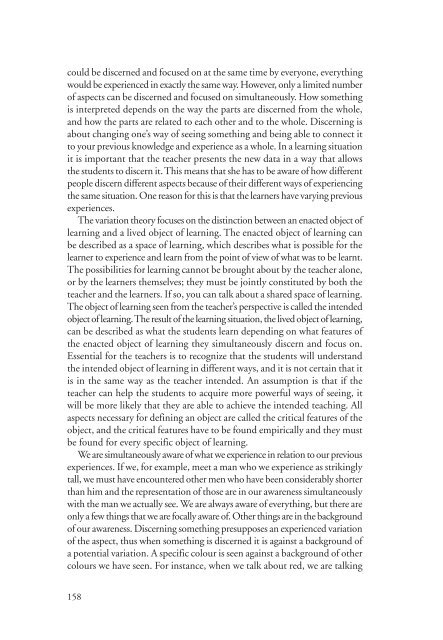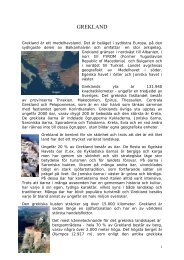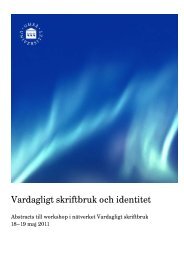Avhandlingens - Umeå universitet
Avhandlingens - Umeå universitet
Avhandlingens - Umeå universitet
You also want an ePaper? Increase the reach of your titles
YUMPU automatically turns print PDFs into web optimized ePapers that Google loves.
could be discerned and focused on at the same time by everyone, everything<br />
would be experienced in exactly the same way. However, only a limited number<br />
of aspects can be discerned and focused on simultaneously. How something<br />
is interpreted depends on the way the parts are discerned from the whole,<br />
and how the parts are related to each other and to the whole. Discerning is<br />
about changing one’s way of seeing something and being able to connect it<br />
to your previous knowledge and experience as a whole. In a learning situation<br />
it is important that the teacher presents the new data in a way that allows<br />
the students to discern it. This means that she has to be aware of how different<br />
people discern different aspects because of their different ways of experiencing<br />
the same situation. One reason for this is that the learners have varying previous<br />
experiences.<br />
The variation theory focuses on the distinction between an enacted object of<br />
learning and a lived object of learning. The enacted object of learning can<br />
be described as a space of learning, which describes what is possible for the<br />
learner to experience and learn from the point of view of what was to be learnt.<br />
The possibilities for learning cannot be brought about by the teacher alone,<br />
or by the learners themselves; they must be jointly constituted by both the<br />
teacher and the learners. If so, you can talk about a shared space of learning.<br />
The object of learning seen from the teacher’s perspective is called the intended<br />
object of learning. The result of the learning situation, the lived object of learning,<br />
can be described as what the students learn depending on what features of<br />
the enacted object of learning they simultaneously discern and focus on.<br />
Essential for the teachers is to recognize that the students will understand<br />
the intended object of learning in different ways, and it is not certain that it<br />
is in the same way as the teacher intended. An assumption is that if the<br />
teacher can help the students to acquire more powerful ways of seeing, it<br />
will be more likely that they are able to achieve the intended teaching. All<br />
aspects necessary for defining an object are called the critical features of the<br />
object, and the critical features have to be found empirically and they must<br />
be found for every specific object of learning.<br />
We are simultaneously aware of what we experience in relation to our previous<br />
experiences. If we, for example, meet a man who we experience as strikingly<br />
tall, we must have encountered other men who have been considerably shorter<br />
than him and the representation of those are in our awareness simultaneously<br />
with the man we actually see. We are always aware of everything, but there are<br />
only a few things that we are focally aware of. Other things are in the background<br />
of our awareness. Discerning something presupposes an experienced variation<br />
of the aspect, thus when something is discerned it is against a background of<br />
a potential variation. A specific colour is seen against a background of other<br />
colours we have seen. For instance, when we talk about red, we are talking<br />
158





